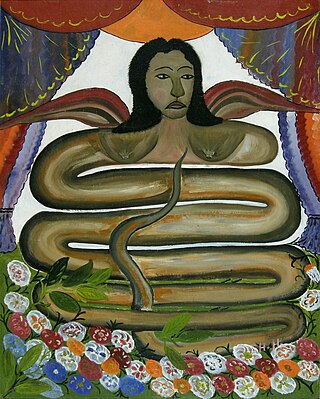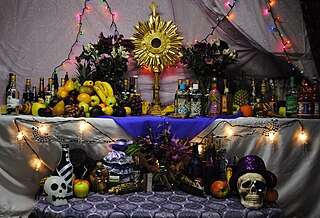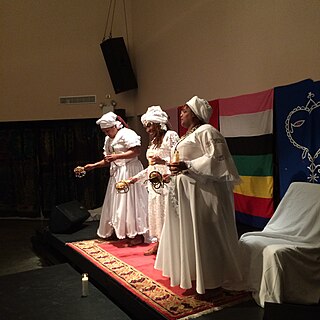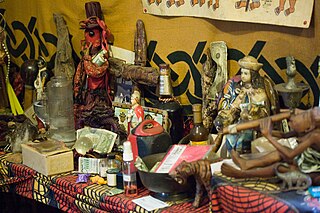Related Research Articles

Lwa, also called loa or loi, are spirits in the African diasporic religion of Haitian Vodou. They have also been incorporated into some revivalist forms of Louisiana Voodoo. Many of the lwa derive their identities in part from deities venerated in the traditional religions of West Africa, especially those of the Fon and Yoruba.

Vodun is a religion practiced by the Aja, Ewe, and Fon peoples of Benin, Togo, Ghana, and Nigeria.

Damballa, also spelled Damballah, Dambala, Dambalah, among other variations, is one of the most important of all loa, spirits in Haitian Voodoo and other African diaspora religious traditions such as Obeah. He is traditionally portrayed as a great white or black serpent, originating in the city of Wedo in modern-day Benin. Damballa is said to be the Sky Father and the primordial creator of all life, or the first thing created by Gran Met. In those Vodou societies that view Damballa as the primordial creator, he created the cosmos by using his 7,000 coils to form the stars and the planets in the heavens and to shape the hills and valleys on earth. In others, being the first thing created by God, creation was undertaken through him. By shedding the serpent skin, Damballa created all the waters on the earth. As a serpent, he moves between land and water, generating life, and through the earth, uniting the land with the waters below. Damballa is usually syncretized with either Saint Patrick or Moses. He is counted among the Rada loa.

Ogun or Ogoun is a spirit that appears in several African religions. He attempted to seize the throne after the demise of Obatala, who reigned twice, before and after Oduduwa, but was ousted by Obamakin and sent on an exile – an event that serves as the core of the Olojo Festival. Ogun is a warrior and a powerful spirit of metal work, as well as of rum and rum-making. He is also known as the "god of iron" and is present in Yoruba religion, Haitian Vodou, and West African Vodun.
Marassa Jumeaux are the divine twins in Vodou. They are children, but more ancient than any other loa. "Love, truth and justice. Directed by reason. Mysteries of liaison between earth and heaven and they personify astronomic-astrological learning. They synthesize the vodou Loa as personification of divine power and the human impotence. Double life, they have considerable power which allow them manage people through the stomach. They are children mysteries."
Haitian Vodou is a syncretic mixture of Roman Catholic rituals developed during the French colonial period, based on traditional African beliefs, with roots in Dahomey, Kongo and Yoruba traditions, and folkloric influence from the indigenous Taino peoples of Haiti. The lwa, or spirits with whom Vodou adherants work and practice, are not gods but servants of the Supreme Creator Bondye. In keeping with the French-Catholic influence of the faith, Vodou practioneers are for the most part monotheists, believing that the lwa are great and powerful forces in the world with whom humans interact and vice versa, resulting in a symbiotic relationship intended to bring both humans and the lwa back to Bondye. "Vodou is a religious practice, a faith that points toward an intimate knowledge of God, and offers its practitioners a means to come into communion with the Divine, through an ever evolving paradigm of dance, song and prayers."
Loco is a loa, patron of healers and plants, especially trees in the Vodou religion. He is a racine (root) and a rada loa. Among several other loa, he is linked with the poteau mitan or center post in a Vodou peristyle.

Oungan is the term for a male priest in Haitian Vodou (a female priest is known as a. The term is derived from Gbe languages. The word hounnongan means chief priest. ‘'Hounnongan or oungans are also known as makandals.

Homosexuality in Haitian Vodou is religiously acceptable and homosexuals are allowed to participate in all religious activities. However, in countries with large Vodou populations, some Christian influence may have given homosexuality a social stigma, at least on some levels of society.
The Petwo, also spelled Petro and alternatively known as dompete, are a family of lwa (loa) spirits in the religion of Haitian Vodou. They are regarded as being volatile and "hot", in this contrasting with the Rada lwa, which are regarded as sweet-tempered and "cool."
The traditional Maya or Mayan religion of the extant Maya peoples of Guatemala, Belize, western Honduras, and the Tabasco, Chiapas, Quintana Roo, Campeche and Yucatán states of Mexico is part of the wider frame of Mesoamerican religion. As is the case with many other contemporary Mesoamerican religions, it results from centuries of symbiosis with Roman Catholicism. When its pre-Hispanic antecedents are taken into account, however, traditional Maya religion has already existed for more than two and a half millennia as a recognizably distinct phenomenon. Before the advent of Christianity, it was spread over many indigenous kingdoms, all with their own local traditions. Today, it coexists and interacts with pan-Mayan syncretism, the 're-invention of tradition' by the Pan-Maya movement, and Christianity in its various denominations.

A manbo is a priestess in the Haitian Vodou religion. Haitian Vodou's conceptions of priesthood stem from the religious traditions of enslaved people from Dahomey, in what is today Benin. For instance, the term manbo derives from the Fon word nanbo. Like their West African counterparts, Haitian manbos are female leaders in Vodou temples who perform healing work and guide others during complex rituals. This form of female leadership is prevalent in urban centers such as Port-au-Prince. Typically, there is no hierarchy among manbos and oungans. These priestesses and priests serve as the heads of autonomous religious groups and exert their authority over the devotees or spiritual servants in their hounfo (temples).
The Rada are a family of lwa spirits in the religion of Haitian Vodou. They are regarded as being sweet-tempered and "cool", in this contrasting with the Petro lwa, which are regarded as volatile and "hot".

Haitian Vodou is an African diasporic religion that developed in Haiti between the 16th and 19th centuries. It arose through a process of syncretism between several traditional religions of West and Central Africa and Roman Catholicism. There is no central authority in control of the religion and much diversity exists among practitioners, who are known as Vodouists, Vodouisants, or Serviteurs.

Louisiana Voodoo, also known as New Orleans Voodoo, is an African diasporic religion which originated in Louisiana, now in the southern United States. It arose through a process of syncretism between the traditional religions of West Africa, the Roman Catholic form of Christianity, and Haitian Vodou. No central authority is in control of Louisiana Voodoo, which is organized through autonomous groups.
Vodou drumming and associated ceremonies are folk ritual faith system of henotheistic religion of Haitian Vodou originated and inextricable part of Haitian culture.
A hounfour is a Vodou temple. The leader of the ceremony is a male priest called a houngan, or a female priest called a mambo. The term is believed to derive from the Fon houn for "abode of spirits."

Dominican Vudú, or Dominican Voodoo, popularly known as Las 21 Divisiones, is a heavily Catholicized syncretic shamanistic religion of African-Caribbean origin which developed in the erstwhile Spanish colony of Santo Domingo on the island of Hispaniola.
Voodoo in popular culture encompasses various representations of practices associated with different forms of voodoo, including Haitian Vodou and Louisiana Voodoo, and other elements attributed to African diaspora religions, with such representations often deviating substantially from any actual voodoo practices or beliefs. Tropes regarding voodoo appear most often in supernatural fantasy or horror films, with common themes including the activity of witch doctors, the summoning or control of dark spirits, use of voodoo dolls to inflict pain on people remotely, and the creation of zombies.
Claudine Michel is the editor of the Journal of Haitian Studies and a professor emerita of Black studies at the University of California, Santa Barbara. Michel is the Director of the UCSB Center for Black Studies Research. She is a Haitian native and practitioner of Haitian Vodou, and has done much in the field of Haitian studies.
References
- ↑ Tann, M.C. 2012 Haitian Vodou: An Introduction to Haiti's Indigenous Spiritual Tradition. Llewellyn: Woodbury, 2012.
- ↑ Férère, Nancy Turnier Vèvè: L'Art Rituel du Vodou Haïtien pub. ReMe Art Publishing and Sandra Osse; 1st Ed. edition (2005) .
- ↑ Desmangles, Leslie G. 2000 The Faces of the Gods: Vodou and Roman Catholicism in Haiti pub. University of North Carolina Press, page 105.
- ↑ Gordon, Leah, (1985), The Book of Vodou, Barron's Educational Series ISBN 978-0-7641-5249-8